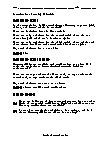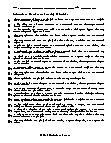Counting Principle Worksheets
What is the Fundamental Counting Principle? Before we get into the fundamental counting principle, it is essential that we first fully understand what probability is as it is used in this form of statistical analysis. Probability is the mathematical calculation of the chances of occurrence of an event. It is calculating by dividing the total number of desired outcomes by the total number of outcomes in the sample space. The sample space is a set that is made up of all possible outcomes of an event. Now that we know what probability and sample space are, we can proceed further and understand what the fundamental counting principle is. It is also known as the counting rule, and it helps in the estimation of the number of outcomes in probability. The formula of this counting principle is simple; all you need to do is, multiply all the events together. The principle states that "if one event has m possible outcomes and a second independent event has n possible outcomes, then there are m x n total possible outcomes for the two events together."
-
Basic Lesson
Introduces the fundamental counting principle. Provides a basic application. If there are p ways to do one thing, and q ways to do another, and r ways to do a third thing, and so on ..., then the number of ways of doing all those things at once is p x q x r x...
View worksheet -
Intermediate Lesson
This lesson focuses on using the counting principle with word problems. In the competition, 8 kids participate. How many ways can gold, silver, and bronze medals be awarded?
View worksheet -
Independent Practice 1
Students practice with 20 counting principle problems. The answers can be found below. An ice cream shop offers 15 flavors. You order a double-scoop cone. In how many different ways can the ice cream be put on the cone if you wanted two different flavors?
View worksheet -
Independent Practice 2
Another 20 counting principle problems. The answers can be found below. If the light bulb comes in your choice of 4 sizes, 4 shapes and 4 different wattages, how many different bulbs can you choose from?
View worksheet -
Homework Worksheet
Reviews all skills in the unit. A great take home sheet. Also provides a practice problem. There are 8 choices for the first medal. There are only 7 choices for the second medal since the one chosen for gold medal can't be chosen again. There are only 6 choices for the third medal, since neither of those chosen for first and second medal be chosen again.
View worksheet -
Skill Quiz
10 problems that test counting principle skills. A student can select one of 2 different history books, one of 3 different geography books and one of 5 different math books. In how many different ways can a student select a book of history, a book of geography and a book of math?
View worksheet -
Basic Lesson
Introduces the fundamental Counting Principle. Provides a basic application.
View worksheet -
Intermediate Lesson
This lesson focuses on using the Counting Principle with word problems. In the competition, 5 kids participate. How many ways can gold, silver and bronze medals are awarded?
View worksheet -
Independent Practice 1
Students practice with 20 Counting Principle problems. The answers can be found below. A lunch special consists of a sandwich, soup, desert, and a drink. There are 5 choices for sandwich, 3 for soup, 5 for desert, 4 for drink. How many lunch specials are there?
View worksheet -
Independent Practice 2
Another 20 Counting Principle problems. The answers can be found below. If you can get 13 kinds of pens in 5 different ink colors, how many different pens are available?
View worksheet -
Homework Worksheet
Reviews all skills in the unit. A great take home sheet. Also provides a practice problem.
View worksheet -
Skill Quiz
10 problems that test Counting Principle skills. A restaurant has 5 sodas that come in 3 different cup sizes. How many different drinks can you order?
View worksheet
In the Purse...
A purse has 47¢ made up of 5 coins. What is the probability of picking out a dime & then without replacing it, picking a quarter? 47¢ = 2 pennies, 2 dimes and a quarter. Chances were 2/5 for the dime, then 1 in 4 for the quarter. Multiply to get 1/10.















